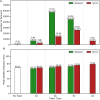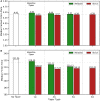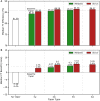Longer Disciplined Tapers Improve Marathon Performance for Recreational Runners
- PMID: 34651125
- PMCID: PMC8506252
- DOI: 10.3389/fspor.2021.735220
Longer Disciplined Tapers Improve Marathon Performance for Recreational Runners
Abstract
For marathoners the taper refers to a period of reduced training load in the weeks before race-day. It helps runners to recover from the stresses of weeks of high-volume, high-intensity training to enhance race-day performance. The aim of this study was to analyse the taper strategies of recreational runners to determine whether particular forms of taper were more or less favorable to race-day performance. Methods: We analyzed the training activities of more than 158,000 recreational marathon runners to define tapers based on a decrease in training volume (weekly distance). We identified different types of taper based on a combination of duration (1-4 weeks of decreasing training) and discipline (strict tapers progressively decrease training in the weeks before the marathon, relaxed tapers do not) and we grouped runners based on their taper type to determine the popularity of different types of taper and their associated performance characteristics. Results: Kruskal-Wallis tests (H(7)≥ 521.11, p < 0.001), followed by posthoc Dunns tests with a Bonferroni correction, confirmed that strict tapers were associated with better marathon performance than relaxed tapers (p < 0.001) and that longer tapers of up to 3 weeks were associated with better performance than shorter tapers (p < 0.001). Results indicated that strict 3-week tapers were associated with superior marathon finish-time benefits (a median finish-time saving of 5 min 32.4 s or 2.6%) compared with a minimal taper (p < 0.001). We further found that female runners were associated with greater finish-time benefits than men, for a given taper type ( ≤ 3-weeks in duration), based on Mann Whitney U tests of significance with p < 0.001. Conclusion: The findings of this study for recreational runners are consistent with related studies on highly-trained athletes, where disciplined tapers were associated with comparable performance benefits. The findings also highlight how most recreational runners (64%) adopt less disciplined (2-week and 3-week) tapers and suggest that shifting to a more disciplined taper strategy could improve performance relative to the benefits of a less disciplined taper.
Keywords: data analysis; marathon performance; marathon taper; marathon training; recreational runners.
Copyright © 2021 Smyth and Lawlor.
Conflict of interest statement
The authors declare that the research was conducted in the absence of any commercial or financial relationships that could be construed as a potential conflict of interest.
Figures







References
-
- Allen E. J., Dechow P. M., Pope D. G., Wu G. (2017). Reference-dependent preferences: Evidence from marathon runners. Manag. Sci. 63, 1657–1672. 10.1287/mnsc.2015.2417 - DOI
-
- Berger B. G., Motl R. W., Butki B. D., Martin D. T., Wilkinson J. G., Owen D. R. (1999). Mood and cycling performance in response to three weeks of high-intensity, short-duration overtraining, and a two-week taper. Sport Psychol. 13, 444–457. 10.1123/tsp.13.4.444 - DOI
-
- Buman M. P., Brewer B. W., Cornelius A. E., Van Raalte J. L., Petitpas A. J. (2008a). Hitting the wall in the marathon: phenomenological characteristics and associations with expectancy, gender, and running history. Psychol. Sport Exerc. 9, 177–190. 10.1016/j.psychsport.2007.03.003 - DOI
LinkOut - more resources
Full Text Sources

